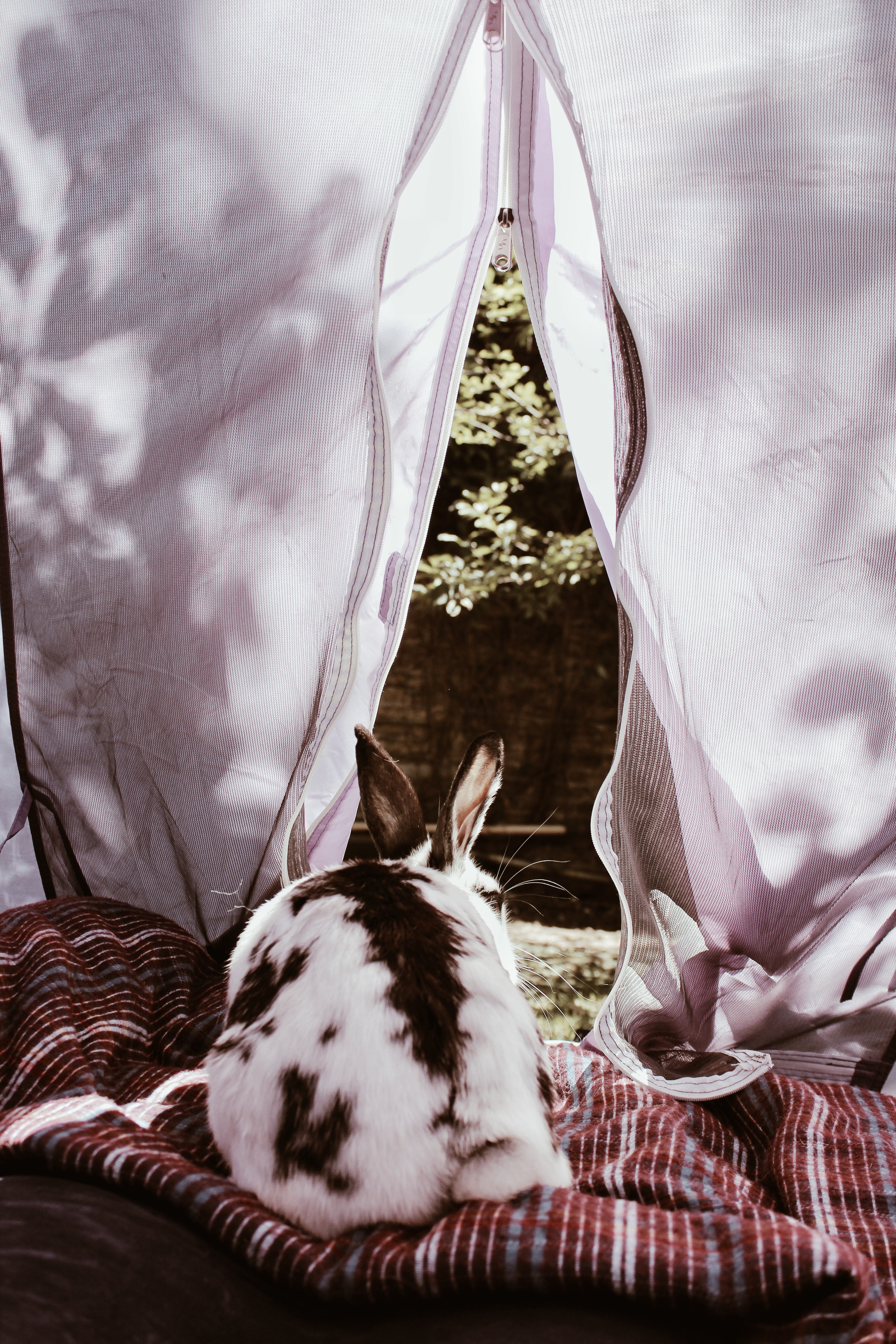My bunnies used to be housed in a giant two-story hutch I made myself with grid panels and wood slats. This was an outdoor enclosure with extra trappings to cool the bunnies in summer and heat them in winter. It was a great habitat, and the bonded pair seemed to enjoy having their own little kingdom to survey.
Spotted, striped, and checkered rabbits all have Charlie genetics.
The female rabbit, Snowy, was a white-and-black Lionhead mix with a little fur mustache, black-tipped ears, and a black dorsal half-stripe. What I didn’t know until later is that this color pattern is one of the many “Charlie” color strains. Charlie rabbits are genetically prone to a disease called megacolon. Her chronically poopy butt was more than an annoyance: it was a symptom of what would kill her. She died very suddenly one day due to a dilated colon and spasms caused by a fatal obstruction.
When one rabbit in a bonded pair dies, the surviving rabbit may lose the will to live.
The surviving male rabbit, Cadbury, was older than the female. He was a Lionlop with a rather curmudgeonly soul. He used to be an indoor free-range rabbit until Snowy, a bunny from wilder stock, made it known that she preferred the outdoors. Once they were bonded, I created an outdoor hutch and that was that. But now that Snowy was gone, it wasn’t good for a grieving rabbit to be outdoors, alone.
When Cadbury refused to eat, I knew he needed to be back indoors with human company.
At first I considered making Cadbury an indoor free-range bunny again, allowed to roam wherever he pleased in the house. But I had moved since those days, and the new place was not easily bunny-proofed. Cadbury had a penchant for nibbling wires, baseboards, and the undersides of sofas. Nicer furniture and an open-plan layout would make it very difficult to keep Cadbury and the house safe from each other. Reluctantly, I started looking at hutches for my little elderly rabbit.
There were not many indoor friendly hutches—well, there were plenty, but they were all far too small. A common misconception about rabbits is that they don’t require space. A rabbit should ideally be able to hop at least eight feet about! Most of the cages available had barely enough room for Cadbury to turn around.
There was also the issue of cost—I was in a tight financial spot at the time, and although my heart was willing to spend $300 on the perfect home for my bunny, my pocketbook simply wouldn’t allow it.
My final choice wasn’t perfect, but it was the best compromise of features and cost.
One feature that drew me to this hutch were its several points of access: a first floor latch door, two second floor latch doors, and a roof opening. Access is paramount especially when you have a bunny that doesn’t like to be handled like Cadbury.

The hutch was also undeniably adorable! Rust brown paint with white trim, a cute rounded roof, and even a little window on the second story loft. As this would be rather prominent in my home, it needed to be easy on the eyes. The rounded roof was an excellent touch which softened the lines; the hutch looked cozy rather than cage-like.



The second story had a removal metal pan so you could use it as a litter tray. I thought this was a great feature in theory though it didn’t quite work out in actuality. Bunnies like to do their business in corners and Cadbury ended up peeing on the walls. All was not lost, though, as I placed the Kaytee Corner Litter Tray in the preferred corner and changed the litter tray via the roof access.

The one thing this hutch was missing was a floor. I wasn’t about to place the hutch on my wool rug and risk a stray bunny marking. At first, I used some ProSource Exercise Mat panels to create a little rubber flooring under the hutch. This didn’t last too long, as Cadbury was able to pry up the interlocking nubs and then gnaw a hole in the mat. So then I bought a Midwest Replacement Crate Tray and lined it with low-pile carpet remnants (most bunnies don’t like to chew low-pile carpet). This protected my own floor, provided Cadbury with a soft space under his paws, and was a cheap setup to replace should the need arise.
Food and water are provided in the delightful carrot water tray and lettuce food bowl, though you could switch them around. That’s just how Cadbury likes it. When I put food into the carrot tray he starts throwing his toys in there in protest!

Space and exercise are important, but so are hiding spaces.
If you looked at this hutch and thought, “that’s not a lot of space,” you’d be right. While it’s definitely an upgrade from your run-of-the-mill rodent cage, it still isn’t big enough for even a single rabbit. While this is Cadbury’s main abode, he is provided with daily opportunities for supervised hops around the home. And as Cadbury gets older, he seems less interested in play. His favorite spot is burrowed in the hutch corner underneath the loft, where he can peacefully watch the world go by.




